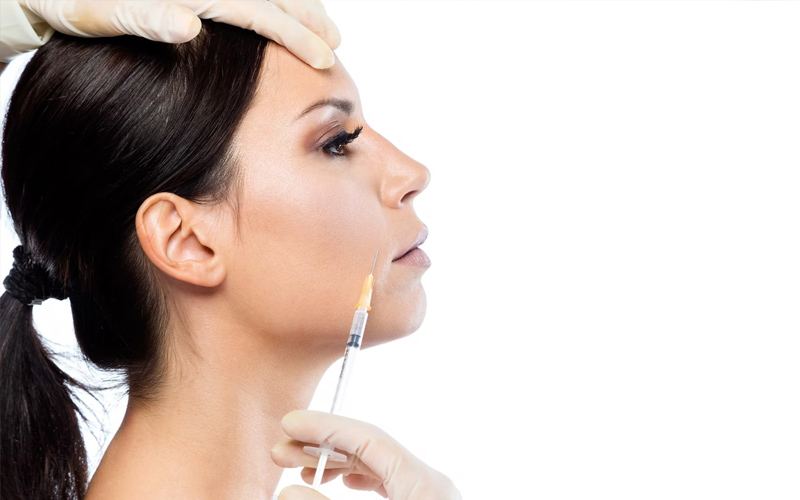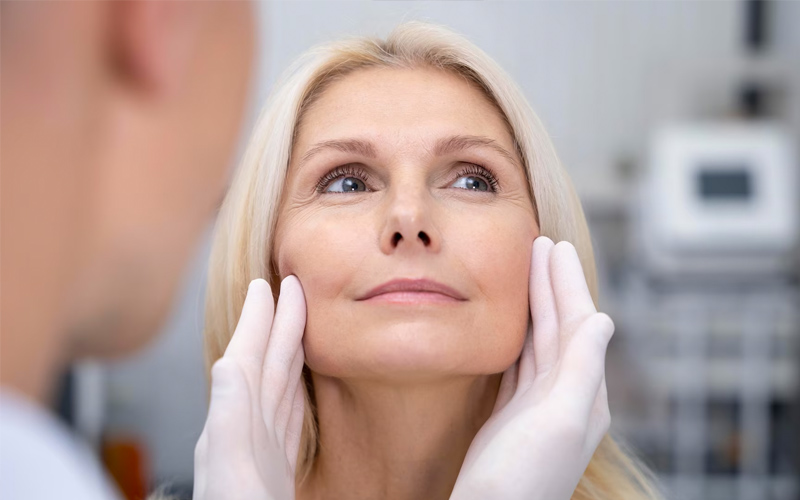Forehead Lift and Brow Lift
The forehead and eyebrows are among the most noticeable areas of the face, and they play a crucial role in facial expressions and aesthetics. For surgeons specializing in oculoplastic and facial plastic surgery, these areas must be carefully considered in any facial procedure.
Forehead Aging and Wrinkles
Horizontal and vertical lines on the forehead are often the first signs of aging for many people. As a result, the forehead is one of the first areas that lead individuals to seek aesthetic treatments. In addition to wrinkles, drooping brows exert pressure on the eyelids, causing a tired, aged appearance. In some cases, heavy, sagging brows can even obstruct vision, leading to feelings of fatigue and discomfort. People with low brows may also experience significant strain during tasks like reading, as they attempt to lift their brows using their forehead muscles, leading to deeper wrinkles and a more pronounced aged appearance.
Mistakes in Forehead and Brow Surgery
An important consideration is that improper cosmetic procedures, whether non-surgical or surgical, can result in undesirable outcomes. Incorrectly positioned brows can lead to problems with eyelid function, asymmetric forehead wrinkles, and sometimes a “frozen” face without natural expressions. Over-lifted brows can create a surprised, shocked, or even frightened appearance, while a stiff, expressionless forehead can look unnatural.
The Importance of Forehead, Brows, and Eyes in Facial Aesthetics
The relationship between the forehead, brows, and eyes is vital for achieving a natural, balanced look. When performing facial procedures, especially in the forehead area, it’s essential to work with a surgeon experienced in oculoplastic and facial plastic surgery principles to achieve the best and most long-lasting results. This expertise helps avoid unnatural appearances and ensures that the patient’s aesthetic goals are met.
Accurate identification of problems in the forehead area is key to selecting the appropriate treatment. Non-surgical treatments like Botox, fillers, and lasers can be effective for some forehead and brow issues. However, in this section, we will focus more on surgical rehabilitation of the forehead and brow areas.
Forehead Lift
As mentioned earlier, the forehead makes up about one-third of the face and plays a critical role in facial expressions. Due to the frequent use of forehead muscles, this area can quickly show signs of aging. Additionally, as discussed, improper surgical procedures in this area can result in unnatural facial expressions such as a permanently surprised or scared look. Therefore, it is essential to evaluate the forehead and brows together in any treatment plan.
Over time, forehead lift techniques have evolved, and today, they can be categorized into two main methods: direct and endoscopic forehead lifts.
In a direct forehead lift, incisions are made at or near the hairline to lift the skin and muscles of the forehead. This method is highly effective for patients with significant sagging or deep wrinkles. While it provides powerful and long-lasting results, the trade-off is the potential for visible scarring, which can be minimized with proper surgical technique and post-operative care.
Endoscopic Forehead Lift
An endoscopic forehead lift is a less invasive method, where small incisions are made behind the hairline, and a camera is used to guide the surgeon. This technique allows for the elevation of the forehead and repositioning of the brows with minimal scarring. Recovery time is typically shorter, and the risk of visible scars is reduced. The endoscopic approach is especially beneficial for patients with mild to moderate sagging or wrinkles who seek a more subtle result.
Brow Lift
As part of the overall forehead rejuvenation, the brow lift addresses drooping brows, which can create a heavy or tired appearance and may even impair vision. A brow lift can be performed in combination with a forehead lift or as a standalone procedure, depending on the patient’s needs.
Combining Techniques
In many cases, a forehead lift is combined with other procedures, such as a brow lift or blepharoplasty (eyelid surgery), to achieve optimal results. The goal is to create a harmonious balance between the upper face and the eyes while avoiding over-correction, which can lead to an unnatural appearance.
Conclusion
The forehead, brows, and eyes are interconnected, and any procedure involving these areas requires careful planning and execution. A comprehensive approach, combining oculoplastic and facial plastic surgery principles, ensures the best possible outcomes for both aesthetics and function. Whether opting for direct or endoscopic techniques, it is essential to work with a skilled surgeon who can provide long-lasting, natural-looking results while minimizing the risk of complications like unnatural facial expressions or scarring.
In the coronal forehead lift procedure, an incision is made within the hairline, allowing the entire forehead area to be released. The muscles that create forehead wrinkles are cut or weakened, reducing the appearance of these lines. Excess skin, along with part of the scalp, is removed, lifting the forehead and, in turn, raising the eyebrows.
However, removing scalp tissue carries a potential risk of future hair loss, making this method less popular. Additionally, the procedure raises the hairline, which can increase the size of the forehead. Therefore, this method is typically not recommended for patients with a naturally high forehead. Another notable disadvantage is that the brow lift achieved through this technique may not always be predictable or consistent.
For these reasons, the coronal forehead lift is generally reserved for specific cases and is not a first choice for patients concerned about potential hairline elevation or hair loss.
When intervention to the scalp is not desired, or in cases where the patient has a naturally wide forehead, a high horizontal forehead lift can be performed. In this procedure, incisions are made just below the hairline, allowing the forehead and brows to be lifted.
While this method avoids manipulation of the hairline, there are some potential drawbacks. The incisions, though placed high on the forehead, may not always be easily concealed, leading to visible scarring. Additionally, the procedure carries a risk of significant bleeding during surgery, which can complicate the operation.
Despite these risks, for patients with a wide forehead or those who prefer not to alter the hairline, this method can be an effective solution for achieving a more youthful and lifted appearance in the forehead and brow area. Proper post-operative care and working with an experienced surgeon are essential to minimizing potential complications.
The mid forehead lift is a technique used in patients with a broad forehead and deep wrinkles, offering easier access to the brows. Incisions are made within the deep forehead wrinkles, allowing the surgeon to reach the muscles responsible for brow drooping and the deep lines between the brows. This technique is particularly effective for improving the appearance of these areas.
However, despite careful planning for aesthetic purposes, one major disadvantage is the potential for visible surgical scars due to the forehead incisions—an undesirable outcome. Additionally, there is a risk of sensory nerve damage, which can result in long-term numbness in the forehead area.
While this method is useful for certain patients, it requires careful consideration of the potential risks, especially in terms of scarring and nerve damage.
In recent years, endoscopic techniques have been developed to address some of the disadvantages associated with traditional forehead and brow lifts, such as visible scars, excessive tissue removal, and significant bleeding during surgery. The endoscopic method involves making smaller incisions hidden within the hairline, allowing access to the forehead and brow tissues while minimizing trauma.
In this approach, the surgeon uses small incisions within the scalp to insert an endoscope (a small camera) and specialized instruments to release the forehead tissue. This provides easier and safer access to the depressor muscles that pull the brows downward, allowing for a more effective brow lift and the reduction of wrinkles between the eyebrows caused by these muscles. Since the incisions are hidden within the hairline, there are no noticeable scars after surgery.
Compared to open techniques, the endoscopic forehead and brow lift offers quicker healing with fewer complications related to scarring. Although the longevity of results may be slightly shorter than with direct methods, patients can still enjoy the benefits for many years.
Key Advantages of Endoscopic Forehead and Brow Lift:
- Minimized scarring: Incisions are hidden within the hairline.
- Faster recovery: Less invasive with quicker healing times compared to open surgery.
- Effective wrinkle reduction: Access to the muscles that cause brow sagging and forehead wrinkles allows for smooth, natural results.
- Long-lasting results: While not as permanent as some direct techniques, the results remain effective for many years.
When performed by an experienced surgeon knowledgeable in oculoplastic and facial plastic surgery, this technique can yield highly satisfactory and natural-looking results. Proper patient selection and careful surgical planning are essential for achieving the best outcomes.





